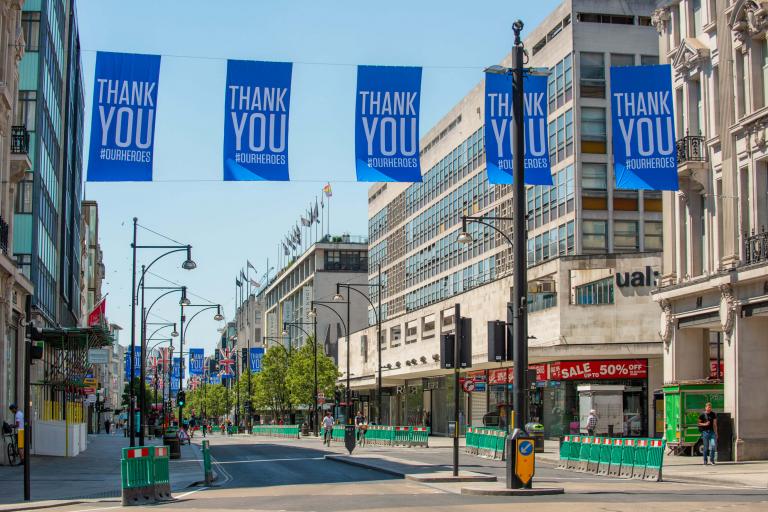Two Westminster estates granted Grade II listing status
The landscaping at both the Brunel Estate in Westbourne Park and Churchill Gardens in Pimlico, were last month awarded Grade II listing status by Historic England.

The landscaping at both the Brunel Estate in Westbourne Park and Churchill Gardens in Pimlico, were last month awarded Grade II listing status by Historic England and have been included on the Register of Historic Parks and Gardens.
The Brunel Estate landscape, designed by Michael Brown in 1970, was recommended for Grade II registration because it is an unusual and intact design by one of the leading professional landscape architects of the time. It is also an example of early 1970s urban housing estate landscaping, which has remained relatively unchanged today, which can be seen in old archive imagery from when the estate was first built.
The landscape play area for older children has changed very little from Brown’s original designs. The most remarkable part is the monumental slide, which is the main attraction for it being listed, both for its architectural brilliance and as a rare surviving example of a play structure of this period and general type. The toddlers’ play area, though still in the same use, has changed over time.
Churchill Gardens, designed by Powell and Moya, was the first large-scale housing development in Britain after the war, and the Grade II listing of the landscape follows in the path of another eight Grade II listed buildings on site, with the whole site made a conservation area in 1990.
The landscape at Churchill Gardens, which is evocative of London’s garden squares, plays a fundamental part of the distinctive character of the whole estate and was awarded Grade II status because it highlights architecture of the post-war period and complements the progressive housing model of its time.
Cllr David Harvey, Cabinet Member for Housing Services at Westminster City Council, says:
“So many of our estates have a rich history to them, so I’m pleased that Historic England has awarded Grade II listing status to celebrate the landscaping on both these estates.
“The slide at the Brunel estate has stood the test of time for thousands of children, and now it has been listed, I hope future generations of children will continue to enjoy using it. More and more of the Churchill Gardens estate continues to be listed, due to it being such an impressive example of post-war architecture.
“By awarding listing status to both landscapes, it will protect the local area surrounding these estates so that local residents can continue to enjoy the outdoor space in the heart of the city.”
Members from the Brunel Estate Sounding Board said:
“We’re pleased that the slide on our estate has been listed as it’s so unique and we’re happy that it’s been recognised and will be preserved for future generations to use. As one child who lives on the estate has said to us, the slide ‘is brilliant’.
“The landscaping of the grounds is special because it’s one large green oasis among residential buildings – we have well over 100 trees and they provide a nice contrast against the surrounding roads and railway tracks, so it’s nice that residents and non-residents alike can enjoy the space.
“We’re happy that the landscape designer, who has given us so many trees, so many green areas and spaces for children to play, has had his work recognised by this Grade II listing. The Sounding Board group has always taken an active role in preserving and improving our environment and homes on the Brunel estate, and this listing reflect this.”
Today, Churchill Gardens has approximately 1,800 flats, with the Brunel Estate having 431 flats.
-Ends-
Notes to Editors
- From the crowd-sourced list of nominations, which was collated by the Gardens Trust, a shortlist of 25 cases was selected by an expert panel comprised of external and internal partners to go forward to full assessment for registration.
- The criteria for assessing designed landscapes for inclusion on the Register of Historic Parks and Gardens state that the older a designed landscape is, and the fewer surviving examples of its kind, the more likely it is to have special interest.
- This shortlist will set the bar and benchmark for future registration casework and includes a range of landscape types over a wide geographical spread.
The Brunel Estate
- The Brunel Estate Sounding Board meets every month with estate managers to help support and improve the estate for residents living there.
- Michael Brown was a leading practitioner in the field of urban landscape design during the 1960s and 1970s, and was one of the first independent professional landscape architects to be employed to work on local authority housing schemes.
- His commissions included landscaping at Beavers Farm, Hounslow, the Grahame Park Estate in Colindale, the Winstanley Estate in Battersea, and Lancaster Road (West) Estate, which surrounds the Grenfell Tower.
- Many of his creations have been lost to development, or diminished – but the Brunel Estate is one of the most compete of his public housing projects.
Churchill Gardens
- Churchill Gardens has a very active Residents Association: http://churchillgardens.org.uk/
- Churchill Gardens Estate was designated a conservation area in 1990. There are 10 listed buildings within the conservation area, eight of them part of the estate built between 1947 and 1962.The first four blocks at Churchill Gardens and the accumulator tower won a Festival of Britain Merit Award in 1951. These five structures, plus Gilbert and Sullivan Houses at the west end of the estate, were listed in 1998.
- The whole estate won two Civic Trust awards in 1962, one for the buildings and one for the landscaping. In 2000 the Civic Trust voted Churchill Gardens the outstanding building scheme of the last forty years.
Published: 10 September 2020
